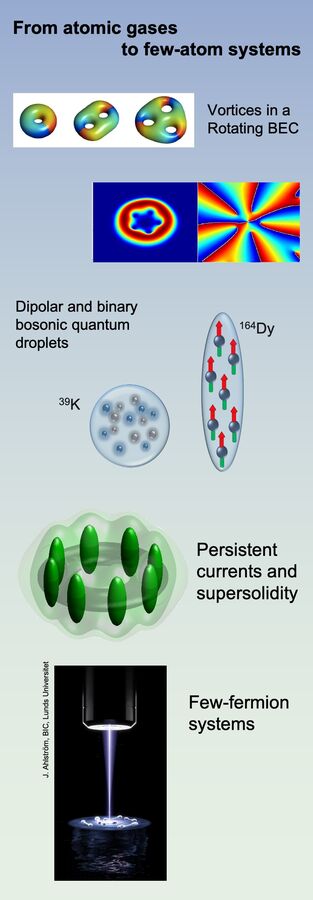Ultracold Atomic Quantum Gases
The field of ultra-cold atomic quantum gases is presently one of the most active areas in modern physics. The interest is spurred by the possibility to experimentally create quantum systems with very unusual physical properties, allowing new insight into fundamental theoretical questions. There is a high degree of experimental control – down to single-atom precision – and one can change basic system parameters, such as the trap geometry, the coupling strength, and even the form of the interactions between the particles. This flexibility opens for intriguing applications of ultra-cold atomic quantum gases, ranging from quantum metrology to “ultra-cold chemistry” with dipolar atoms or molecules or quantum information processing.
Research at Mathematical Physics in this area concerns novel types of few- and many-body quantum systems with cold atoms at the crossover between microscopic and “thermodynamic” behavior, studying precursors of phase transitions and hitherto unknown states of quantum matter in finite quantum systems. We focus on fundamental theoretical questions while working closely in contact with the experiment.
Bose-Einstein condensation
When brought to sufficiently low temperatures, a dilute gas of bosonic atoms may undergo a phase transition to a Bose-Einstein condensate (BEC), bringing microscopic quantum effects onto a macroscopic scale. Predicted by Bose and Einstein in the 1920s, the phenomenon first connected with the superfluid properties of liquid helium. As late as 1995, BEC was made possible by the celebrated advances in atom-optical cooling techniques, opening a new field of research that today has matured to one of the most active areas in physics. BEC is, in principle, a purely statistical phenomenon. Nevertheless, and despite the diluteness of the gas, the interactions between the atoms (or molecules) may play an important role. They are usually short-range, but BEC was also realized with dipolar quantum gases. Trapped BCE’s have given access to a broad range of new and exciting quantum phenomena, both in and out of equilibrium.
Quantum droplets
In experiments with ultra-cold and ultra-dilute bosonic quantum gases, a novel state of matter was discovered: self-bound droplets form out of a gaseous Bose-Einstein condensate of dysprosium or potassium in different hyperfine states. These novel quantum liquids stabilize because of quantum fluctuations. They have fascinating and unexpected properties, such as dimension-dependent liquefaction, the formation of filament-like states, and collective excitations above the threshold for single-atom emission. Work at Mathematical Physics theoretically explores this new form of self-bound quantum matter that may have properties superseding those of liquid helium.
Ultra-cold Fermi gases
Tunable few-fermion systems in atomic traps have been realized experimentally with single-atom control (see eg. the page of the Heidelberg group, lithium6.de). Few-fermion traps provide a novel tool to study quantum magnetism. It also became possible to analyze paired fermion states in low dimensions. In close collaboration between theory and experiment, we found a few-body precursor of a quantum phase transition from a normal to a superfluid phase, signaled by the softening of a mode analogous to the Higgs mechanism in particle physics.
Faculty at the division working in the area [links open the person's homepage]:

